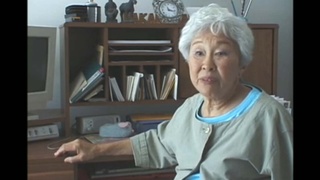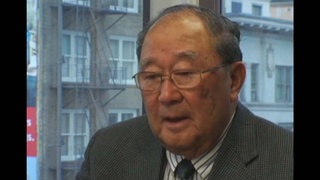Interviews
Winners and losers
Then, in 1941, at the end of July in Showa 16, the publication of newspapers in foreign languages was banned. As a result, the vast majority of Japanese people could not speak Portuguese, so they ended up not being able to understand the news in the Japanese newspapers. Then, the war started, and the only news from Japan they could hear was through shortwave radio, and when the war ended, people started arguing about whether Japan had won or lost. So things like winners and losers, something that would be unthinkable today, started happening.
Those who recognized that Japan had lost were the so-called intellectuals in the Japanese community who could speak Portuguese or English, but the Shindo Renmei and such ended up making those who said that Japan had lost seem like traitors, and so, looking back at it now, what happened was a bit, how should I put it, completely unreasonable. I believe about 23 people, the so-called recognition group, the defeat group, were killed, 150 to 160 people were injured, and the Brazilian government couldn't just leave it alone, so they arrested those people and sent them to a prison on an island called Anchetta, on the northern coast of Sao Paulo state.
In 2008, on the 100th anniversary, some people came forward and said, "I wonder who I killed." The message book that he had wrapped around his stomach is now on display at the Immigration Museum.
Date: September 19, 2019
Location: California, US
Interviewer: Yoko Nishimura
Contributed by: Watase Media Arts Center, Japanese American National Museum
Explore More Videos

Importance of education in achieving redress for incarceration
(1919-2014) Activist for civil rights and redress for World War II incarceration of Japanese Americans.

Her experience as a Japanese-American schoolchild in Oceanside, California, after the bombing of Pearl Harbor
(1924-2018) Artist and playwright.

Loss of happy-go-lucky adolescence in Puyallup Assembly Center
(b. 1923) Nisei from Washington. Resisted draft during WWII.

Memories of dusty conditions at Minidoka incarceration camp
(b. 1923) Nisei from Washington. Resisted draft during WWII.

Making the decision to resist the draft
(b. 1923) Nisei from Washington. Resisted draft during WWII.

Discharged from the U.S. Army after Pearl Harbor
(b. 1918) Founder Azumano Travel

Reaction to a 1942 speech by Mike Masaoka, Japanese American Citizen League's National Secretary
(1915 - 2011) Nisei florist who resettled in New York City after WW II. Active in Japanese American civil rights movement

Death of sister in October 1942
(1915 - 2011) Nisei florist who resettled in New York City after WW II. Active in Japanese American civil rights movement

First impression of New York City during war time
(1915 - 2011) Nisei florist who resettled in New York City after WW II. Active in Japanese American civil rights movement

Neighbors' sympathy after Pearl Harbor
(1915 - 2011) Nisei florist who resettled in New York City after WW II. Active in Japanese American civil rights movement

Reaction of Japanese American community toward draft resistance stance
(b. 1925) Draft resister

The role of the media in influencing people's opinions
(b. 1925) Draft resister

Living conditions in prison while serving time for resisting the draft
(b. 1925) Draft resister

Talking to children about decision to resist the draft during World War II
(b. 1925) Draft resister

Deciding whether to answer "yes-yes" on the loyalty questionnaire in order to leave camp
(b. 1925) Draft resister
